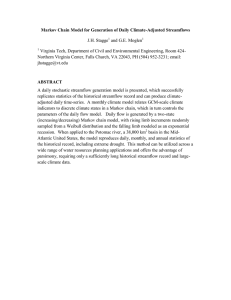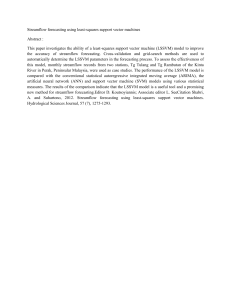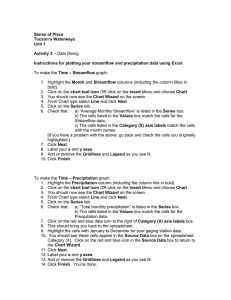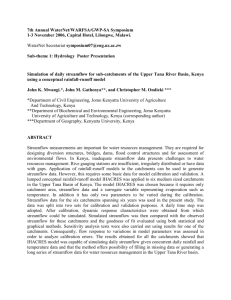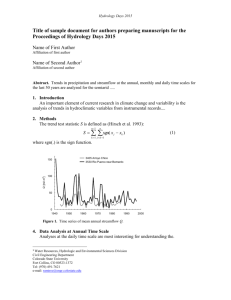Analysis Techniques: Monthly Analysis Mean Monthly Flow
advertisement
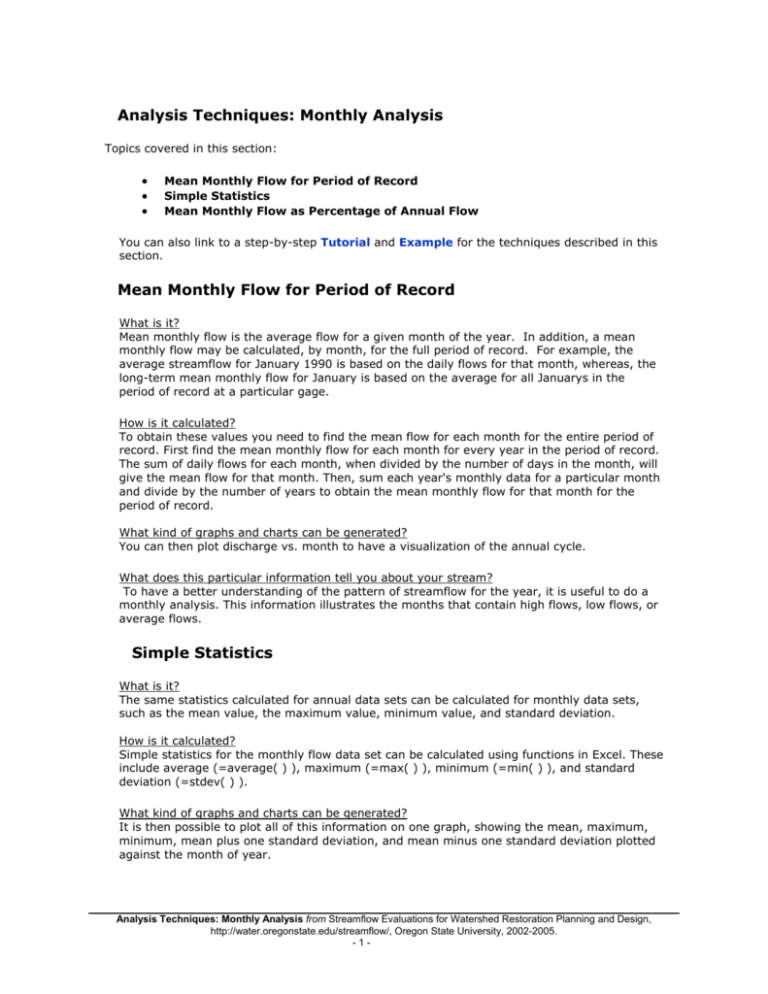
Analysis Techniques: Monthly Analysis Topics covered in this section: • • • Mean Monthly Flow for Period of Record Simple Statistics Mean Monthly Flow as Percentage of Annual Flow You can also link to a step-by-step Tutorial and Example for the techniques described in this section. Mean Monthly Flow for Period of Record What is it? Mean monthly flow is the average flow for a given month of the year. In addition, a mean monthly flow may be calculated, by month, for the full period of record. For example, the average streamflow for January 1990 is based on the daily flows for that month, whereas, the long-term mean monthly flow for January is based on the average for all Januarys in the period of record at a particular gage. How is it calculated? To obtain these values you need to find the mean flow for each month for the entire period of record. First find the mean monthly flow for each month for every year in the period of record. The sum of daily flows for each month, when divided by the number of days in the month, will give the mean flow for that month. Then, sum each year's monthly data for a particular month and divide by the number of years to obtain the mean monthly flow for that month for the period of record. What kind of graphs and charts can be generated? You can then plot discharge vs. month to have a visualization of the annual cycle. What does this particular information tell you about your stream? To have a better understanding of the pattern of streamflow for the year, it is useful to do a monthly analysis. This information illustrates the months that contain high flows, low flows, or average flows. Simple Statistics What is it? The same statistics calculated for annual data sets can be calculated for monthly data sets, such as the mean value, the maximum value, minimum value, and standard deviation. How is it calculated? Simple statistics for the monthly flow data set can be calculated using functions in Excel. These include average (=average( ) ), maximum (=max( ) ), minimum (=min( ) ), and standard deviation (=stdev( ) ). What kind of graphs and charts can be generated? It is then possible to plot all of this information on one graph, showing the mean, maximum, minimum, mean plus one standard deviation, and mean minus one standard deviation plotted against the month of year. Analysis Techniques: Monthly Analysis from Streamflow Evaluations for Watershed Restoration Planning and Design, http://water.oregonstate.edu/streamflow/, Oregon State University, 2002-2005. -1- What does this particular information tell you about your stream? Most fundamentally, these values show seasonal patterns and their variability over the period of record. For design purposes it is also useful to know the likely common range of values for monthly flows (e.g., those that occur within one standard deviation of the mean value for each month). Depending on the type of project, it is then possible to identify the likely range of design discharges that need to be considered. Mean Monthly Flow as a Ratio of Annual Flow and as a Percentage of Annual Flow What is it? This calculation tells you what ratio or percentage of the annual flow occurs in each month of the year. How is it calculated? Once the mean monthly flow for each month has been calculated, this value should be divided by the mean annual flow for period of record to obtain a ratio. The ratio multiplied by 100 gives a percentage. [Mean Monthly Flow / Mean Annual Flow for Period of Record] X 100 For Example: [Mean Monthly Flow for January / Mean Annual Flow for Period of Record] X 100 What does this particular information tell you about your stream? When interested in seasonal aspects of flow at a site or when working with more than one site, it is useful to be able to “normalize” values for comparison. For example, you could get some idea of how much of the stream’s flow occurs in winter. As another example, if you were working at two different sites and wanted to compare the monthly discharge values, it would be useful to have a normalized value to compare. For normalization purposes, monthly flow values can be viewed as percentages of annual flow values. Tutorial | Example (What is the difference between Tutorial and Example files? Click here for an explanation...) Analysis Techniques: Monthly Analysis from Streamflow Evaluations for Watershed Restoration Planning and Design, http://water.oregonstate.edu/streamflow/, Oregon State University, 2002-2005. -2-
